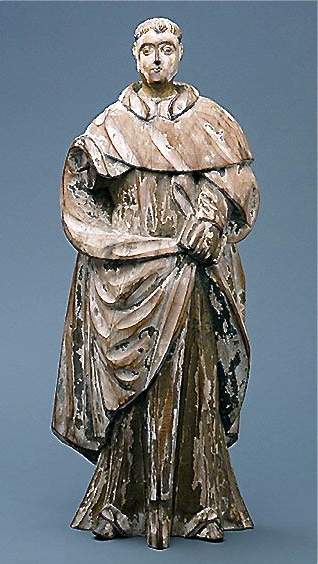

Title: Antique Religious Spanish Polychrome Wooden Carved Santo Figure
Shipping: $49.00
Artist: N/A
Period: Unassigned
History: N/A
Origin: N/A
Condition: Good
Item Date: 1700 to 1900
Item ID: 5762
Antique Hand Carved Spanish Colonial Polychrome Wood Santo Figure {Height 19 3/4 inches} [missing one arm] late 18th/early 19th c., figure with movable head. losses to carving, heavy signs of age, losses to paint, see images. hand carved Spanish colonial wood ... Antique carved wooden "santo" religious figure, it looks to be from Europe. Santo, are the association of specific iconic attributes to a saints image. From a religious perspective, the practice of owning and maintaining Santo images are often regarded as a mild Catechism for people, especially with regards to the iconic attributes attached to the images. A caretaker of a Santo image is often referred to as Camarero (female: "Camarera"), a Spanish term for "chamber-person"). We are committed to enhancing our customer’s lives by discovering creating, and pointing out only the best art we can find in the world today. We Are Taste-Makers, Art Advisers, Consultants & Publishers of Great Stories.
Link: http://en.wikipedia.org/wiki/Polychrome
Polychrome is the "'practice of decorating architectural elements, sculpture, etc., in a variety of colors."[1] The term is used to refer to certain styles of architecture, pottery or sculpture in multiple colours.
Throughout medieval Europe religious sculptures in wood and other media were often brightly painted or coloured, as were the interiors of church buildings. These were often destroyed or whitewashed during iconoclast phases.
In ancient Greece sculptures were painted in strong colours. The paint was frequently limited to parts depicting clothing, hair, and so on, with the skin left in the natural colour of the stone. But it could cover sculptures in their totality. The painting of Greek sculpture should not merely be seen as an enhancement of their sculpted form but has the characteristics of a distinct style of art. For example, the pedimental sculptures from the Temple of Aphaia on Aegina have recently been demonstrated to have been painted with bold and elaborate patterns, depicting, amongst other details, patterned clothing. The polychrome of stone statues was paralleled by the use of materials to distinguish skin, clothing and other details in chryselephantine sculptures, and by the use of metals to depict lips, nipples, etc., on high-quality bronzes like the Riace bronzes.